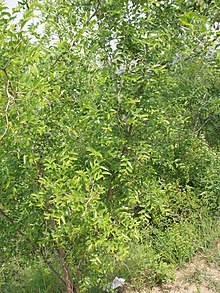Jujube
| Ziziphus jujuba | |
|---|---|
 |
|
| Ziziphus jujuba | |
| Scientific classification | |
| Kingdom: | Plantae |
| (unranked): | Angiosperms |
| (unranked): | Eudicots |
| (unranked): | Rosids |
| Order: | Rosales |
| Family: | Rhamnaceae |
| Genus: | Ziziphus |
| Species: | Z. jujuba |
| Binomial name | |
|
Ziziphus jujuba Mill. |
|
| Synonyms | |
|
|

Fresh jujube fruit
|
|
| Nutritional value per 100 g (3.5 oz) | |
|---|---|
| Energy | 331 kJ (79 kcal) |
|
20.23 g
|
|
|
0.2 g
|
|
|
1.2 g
|
|
| Vitamins | |
| Vitamin A equiv. |
(5%)
40 μg |
| Thiamine (B1) |
(2%)
0.02 mg |
| Riboflavin (B2) |
(3%)
0.04 mg |
| Niacin (B3) |
(6%)
0.9 mg |
| Vitamin B6 |
(6%)
0.081 mg |
| Vitamin C |
(83%)
69 mg |
| Minerals | |
| Calcium |
(2%)
21 mg |
| Iron |
(4%)
0.48 mg |
| Magnesium |
(3%)
10 mg |
| Manganese |
(4%)
0.084 mg |
| Phosphorus |
(3%)
23 mg |
| Potassium |
(5%)
250 mg |
| Sodium |
(0%)
3 mg |
| Zinc |
(1%)
0.05 mg |
| Other constituents | |
| Water | 77.86 g |
|
|
|
|
|
| Percentages are roughly approximated using US recommendations for adults. Source: USDA Nutrient Database |
|

Jujube fruit naturally turns red upon drying.
|
|
| Nutritional value per 100 g (3.5 oz) | |
|---|---|
| Energy | 1,201 kJ (287 kcal) |
|
73.6 g
|
|
|
1.1 g
|
|
|
3.7 g
|
|
| Vitamins | |
| Vitamin A equiv. |
(0%)
0 μg |
| Thiamine (B1) |
(18%)
0.21 mg |
| Riboflavin (B2) |
(30%)
0.36 mg |
| Niacin (B3) |
(3%)
0.5 mg |
| Vitamin B6 |
(0%)
0 mg |
| Vitamin C |
(16%)
13 mg |
| Minerals | |
| Calcium |
(8%)
79 mg |
| Iron |
(14%)
1.8 mg |
| Magnesium |
(10%)
37 mg |
| Manganese |
(15%)
0.305 mg |
| Phosphorus |
(14%)
100 mg |
| Potassium |
(11%)
531 mg |
| Sodium |
(1%)
9 mg |
| Zinc |
(2%)
0.19 mg |
| Other constituents | |
| Water | 19.7 g |
|
|
|
|
|
| Percentages are roughly approximated using US recommendations for adults. Source: USDA Nutrient Database |
|
Ziziphus jujuba (from Greek ζίζυφον, zízyphon), commonly called jujube (/ˈdʒuːdʒuːb/; sometimes jujuba), red date, Chinese date,Korean date, or Indian date is a species of Ziziphus in the buckthorn family (Rhamnaceae). It is used primarily as a shade tree that also bears fruit.
It is a small deciduous tree or shrub reaching a height of 5–12 metres (16–39 ft), usually with thorny branches. The leaves are shiny-green, ovate-acute, 2–7 centimetres (0.79–2.76 in) wide and 1–3 centimetres (0.39–1.18 in) broad, with three conspicuous veins at the base, and a finely toothed margin. The flowers are small, 5 millimetres (0.20 in) wide, with five inconspicuous yellowish-green petals. The fruit is an edible oval drupe 1.5–3 centimetres (0.59–1.18 in) deep; when immature it is smooth-green, with the consistency and taste of an apple, maturing brown to purplish-black and eventually wrinkled, looking like a small date. There is a single hard seed similar to an olive pit.
Its precise natural distribution is uncertain due to extensive cultivation, but is thought to be in southern Asia, between Lebanon, northern India, and southern and central China, and possibly also southeastern Europe though more likely introduced there.
This plant has been introduced in Madagascar and grows as an invasive species in the western part of the island. This plant is known as the "hinap" or "finab" in the eastern part of Bulgaria where it grows wild but is also a garden shrub, kept for its fruit. The fruit is picked in the autumn. The trees grow wild in the eastern Caribbean, and are reported to exist in Jamaica and Trinidad as well. In Antigua and Barbuda, the fruit is called "dumps" or "dums". It is also known as "pomme surete" on the French islands of the Caribbean. This fruit, more precisely known as "Indian jujube" elsewhere, is different from the "jujube" fruit that is cultivated in various parts of southern California.
...
Wikipedia
